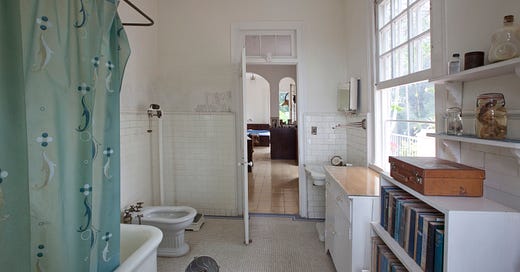Bathroom at Finca Vigia in Havana, photograph by Carol M. Highsmith, Library of Congress; taxidermined kudu and impala heads, from Hemingway’s African safaris, hanging on the fireplace at the Hemingway House in Ketcham, Idaho
CUBA. MARTHA (continued)
Also here is a very un-Jungian tower, built as a guest house for his visiting boys, the ground floor reserved for cats, a splendid pool even larger than the one in Key West, a tennis court, and a cock-fighting ring. There is also a little strip cemetery for dogs. Four markers memorialize Black, Negrita, Neron, and Linda. The forty plus cats, disdained by Martha, don’t have a cemetery. They seem to have made do without one. When Martha suggested neutering the males Hemingway said he’d shoot them all before doing such a thing. Later he said he would shoot her if she tried to divorce him. He was just kidding though. He actually wanted a divorce because he wanted to marry Mary, whom he had met at the Dorchester Hotel in wartime London. She was a petite, personable woman who was a journalist of sorts and was involved in affairs with a general, a spy, and the novelist Irwin Shaw. Blacked-out great cities could be romantically thrilling for some.
Keep reading with a 7-day free trial
Subscribe to Book Post to keep reading this post and get 7 days of free access to the full post archives.




